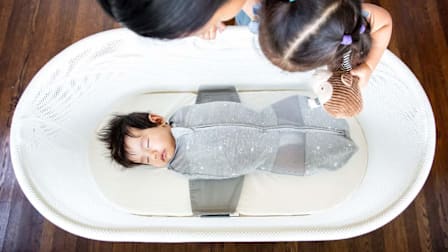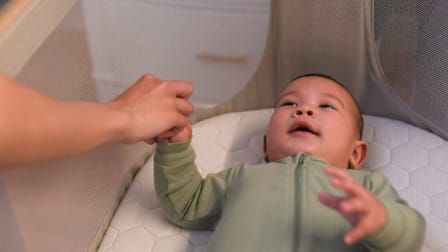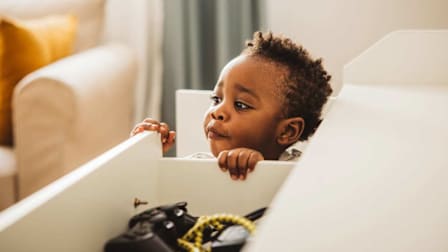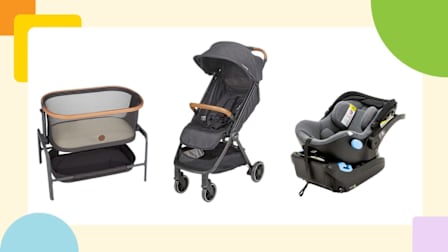White Noise for Babies: It’s ‘Confusing’
A new AAP policy report ‘sounds alarm’ on childhood hearing damage
Despite the term “sleep like a baby,” newborns are not good sleepers. They typically must eat every couple of hours, at least at first; they poop in their diapers, which is uncomfortable for them and sometimes wakes them (understandable); and they can be sensitive to stimulation, such as noise, lights, or temperature.
Parents are increasingly turning to white noise machines in an attempt to coax their babies to sleep (and get some sleep themselves). Because white noise vaguely mimics the sounds babies hear in the womb, it can relax babies, as well as block out more annoying noises that keep babies awake. In so doing, white noise can help babies sleep, and often comes as a feature on “smart bassinets” such as the Snoo and the 4moms MamaRoo, which rock and play white noise, among other sounds, to help babies fall asleep. Note: Both of these smart bassinets, along with a third model from Fisher-Price, are in our bassinet ratings.
How Sound Can Damage a Baby’s Hearing
The AAP policy statement cites a study that found that white noise machines that played noise so loud (more than 85 decibels—about as loud as a blender) that they exceeded occupational limits for noise exposure for adults and can damage hearing if played for more than 8 hours. While that might seem like a longer time than a caregiver may play white noise for a baby, if a caregiver is trying to get their baby to rest through the standard evening’s worth of sleep, that’s 8 hours (or more) of white noise. And because current occupational limits are crafted for adults, not children or infants, it’s possible that the capacity for harm from white noise is even greater for a baby in a bassinet than an employee working in, say, a factory.
“What happens with noise exposure is that it’s kind of a cumulative effect,” says Derek Stiles, PhD, the director of the diagnostic audiology program at Boston Children’s Hospital. The ear has thousands of cells, and if you damage some, you might not notice at first, he says. But damage accumulates over time—and eventually, your hearing might be significantly affected (and you might not hear as well). “Over time, the effects can be seen. But a lot of times in childhood, the damage is too subtle to be detected, but it’s there.”
Research shows that some people have hearing damage and don’t even know it. According to the Centers for Disease Control and Prevention, a quarter of people with noise-induced hearing damage didn’t know they had it, according to a large survey conducted from 2011 to 2012. Another review found that 1 in 5 middle and high schoolers have hearing damage. According to the AAP, because so many children have hearing damage, interventions are needed from an early age.
Infants and children are surrounded by sounds that can cause damage to their hearing before they even become adults. White noise machines (including those in bassinets); traffic sounds; leaf blowers, lawn mowers, and other devices that the AAP cites as “powered by fossil fuels,” appliances; and televisions and video games are all counted among sources of potentially damaging sounds.
What This Means for Your Bassinet
Consumer Reports has tested three bassinets that play white noise: the Happiest Baby Snoo Smart Bassinet, 4moms MamaRoo Sleep Bassinet, and Fisher-Price Soothing Motions Bassinet. All three use sound, including white noise, to soothe babies to sleep. As has been shown in research, white noise can be helpful in calming infants and getting them to sleep, an undoubtedly critical feature that many parents appreciate. As the AAP notes, however, that needs to be measured against potential cumulative harm posed by white noise, among other sounds; parents can mitigate these harms by placing white noise machines as far away as possible from the baby, on a low setting, and for a limited amount of time only.
“With any kind of noise, the duration is really one of the key things” that can lead to hearing damage—so a white noise machine that plays all night probably isn’t a good idea, says Stiles. “I feel like an auto shutoff would be important, something that within an hour clicks itself off. I don’t think that there’s a reason for it to be on all night.”
Of the three bassinets we tested, two of them—the 4moms MamaRoo and the Fisher-Price Soothing Motions—allow manual control of the volume on the white noise machine, including all the way down to “mute” or “off.” The Snoo by Happiest Baby, however, does not allow caregivers to turn off the white noise unless they want to turn off all functions of the device altogether. Happiest Baby did not directly answer our question when we emailed the company inquiring whether, in light of the AAP’s new policy statement about noise, the company had plans to allow caregivers to turn off the white noise function. “The SNOO is not a source of excessive noise,” it said. “SNOO only increases the sound level when the infant is crying, which is unlike standard sound machines and is fully in-line with the AAP’s stance on limiting extended exposures to loud sound.”
At its lowest level, the Snoo plays sounds between 65 to 70 decibels, and at its highest, it reaches about 86 decibels, according to Happiest Baby.
In fact, the Snoo we tested never got that loud: When we measured the decibel levels of the Snoo in our lab at a distance to approximate where a baby’s head would be, the highest volume we saw was 71.7 decibels.
According to the AAP, “extended periods” of noise over 70 decibels can damage hearing—calling into question whether parents should use white noise machines with limited volume capabilities, such as those in the Snoo, overnight.
It’s worth noting that the 70 dB level was determined by research that wasn’t done on infants. Balk says, adding that while the AAP Policy Statement and Technical report discussed white noise machines, it did not discuss smart bassinets like the Snoo. Balk also noted that there is concern that infants and children may be more vulnerable to noise than adults because of their developing cognition and the fact that they have less control over their environments.
There currently isn’t a lot of research or information on how long-duration loud white noise affects an infant’s brain, according to Stiles. So even if 72 dB might be considered safe with regards to noise damage, there is the potential that continuous noise of this level might have some unknown effect on brain development, Stiles says.
“If we look at the big picture, I think it’s wise that parents take into consideration these devices and the noise that they make, and they should try to minimize the volume that’s exposed to children over long periods of time,” says Elias Michaelides, MD, the medical director for outpatient otorhinolaryngology and audiology at Rush University Medical Center.
“It’s a confusing time for parents. You want your baby to sleep well and you want to protect their hearing—but it’s hard to know whether you’re striking the right balance,” says William Wallace, associate director of safety policy for Consumer Reports. “We’re not saying you should stop using bassinets with a built-in sound machine, but it’s important to be aware of potential risks. It would be really helpful for parents if there were federal standards for children’s noise exposure, based on additional rigorous research into the risks to babies and kids.”
In its policy statement, the AAP recommends that noise in children’s products should be regulated on a federal level, and that new standards should take into account that children’s ears are more vulnerable than adult ears, at which current occupational standards are set.






























